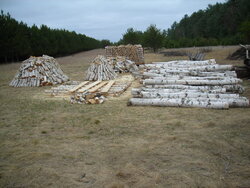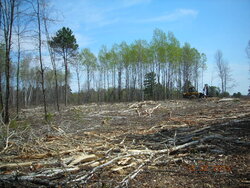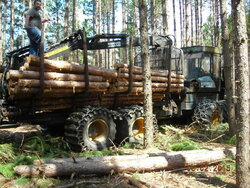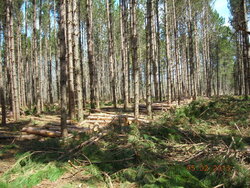So the state is doing this on your property but on their dime? Is it compulsory or voluntary?
Our logging is purely voluntary, except for an incentive payment, and we pay 100% of the costs and we receive 100% of the proceeds from the logging. The USDA/NRCS provided the educational material and forester assistance to plan a harvest in the aspen/birch area that would provide both high quality breeding habitat and also cover habitat for the fledged young warblers, along with an incentive payment. The incentive payment helps to offset the loss of timber value related to mature trees cover habitat which are left in the harvest area. We also set aside surrounding forest cover area for 10 years for no logging, again to insure maximum quality habitat for the GWW. Our set aside area is generally young forest and we normally would not be logging this area anyway within 10 years.
Our area of MN, as mentioned in the reference which follows: "Minnesota has the highest remaining density of Golden-winged Warblers, with about half the global population." And the involved area of Minnesota is roughly the NE quadrant which is heavily forested." [
URL="http://www.allaboutbirds.org/guide/Golden-winged_Warbler/lifehistory/"]GWW[/URL]
The warblers must nest in mostly open ground?
Tangled thickets, as the GWW article states.
What are they doing with the wood they're hauling out on that articulated truck...assuming that's not your fancy piece of equipment?
The machine shown in the picture below the birch picture is a cut-to-length harvester. It grabs the tree, cuts the tree at about 6" above the ground, rotates the tree to a horizontal position, simultaneously shears the branches and cuts the stem of the tree into 100" lengths. The tree stem is usable down to about 3-5" depending on its condition at this point. The sheared branches are dropped in front of the harvester so that as it moves through the forest it drives over the branches rather than tearing up the ground. Driving over the branches also breaks them up to a fair extent and scars them, which aids a speedy decomposition of the slash. The harvester then drops the logs in piles through the harvested area.
The articulated machine is a forwarder. It drives through the cut area, picks up the logs, and then forwards the logs to a landing area and stacks them. Logging trucks then arrive, load the logs, and haul the logs to the mills. Different mills take different species (pine, spruce, aspen, birch are the primary trees in our forest lands).
The slash area is not "pretty" immediately after a harvest. I scavenge this area for rejects and trimmings for stove wood. But in 1-4 years new growth of young trees and shrubs springing from the roots in the aspen/birch area are abundant, the slash is not visible, and the slash soon decomposes to add to the soil and support a new forest.
The pine thinning harvesting operates similarly, except that our pine/spruce thinning is from densely planted trees planted years ago. Not too much grows in the understory of a dense pine/spruce forest. The thinning leaves quality trees with adequate exposure to sunlight and soil resources so that they continue to grow into future, high quality mature trees for lumber, etc.
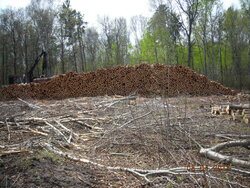
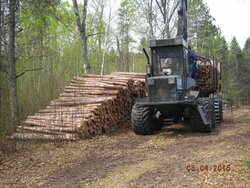
[/URL]
